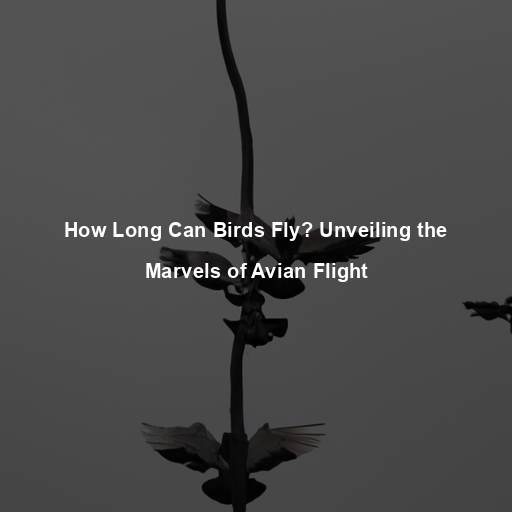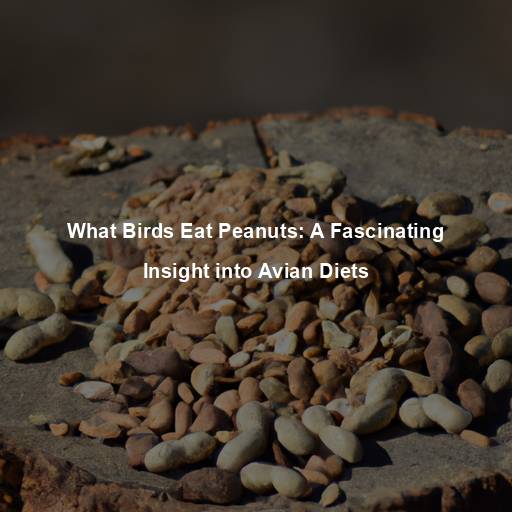How Long Can Birds Fly? Unveiling the Marvels of Avian Flight
Last Updated on November 8, 2023 by Evan
Contents [hide]
- 1 The Fascinating World of Avian Flight
- 2 The Phenomenon of Bird Migration
- 3 A Delicate Balance: Conservation Challenges
- 4 Celebrating the Majesty of Avian Flight
- 5 FAQs about how long birds can fly
The Fascinating World of Avian Flight
Birds, with their graceful wings and soaring flights, have captivated human imagination for centuries. From the majestic bald eagle to the tiny hummingbird, these feathered creatures possess the remarkable ability to traverse vast distances through the skies. But have you ever wondered: how long can birds actually fly without rest? Join us as we embark on a journey through the awe-inspiring realm of avian flight, where we unravel the secrets behind their endurance, adaptability, and astonishing migratory journeys.
The Marvel of Migration
The awe-inspiring phenomenon of migration is a captivating spectacle witnessed in various avian species. Year after year, countless birds embark on an extraordinary odyssey, traversing vast continents while braving a myriad of terrains and unpredictable climates. These remarkable feathered adventurers demonstrate unwavering determination as they undertake unimaginable distances, oftentimes without respite, all in pursuit of their annual breeding grounds or sought-after winter sanctuaries. The sheer magnitude of their journeys is both perplexing and awe-inspiring, leaving us marveling at the resilience and resoluteness of these remarkable creatures.
Epic Journeys
Some birds embark on truly epic journeys, pushing the boundaries of endurance and resilience. The Arctic Tern, known as the “champion of migration,” travels an astonishing round trip of over 40,000 kilometers (24,000 miles) from its breeding grounds in the Arctic to its wintering grounds in Antarctica. This remarkable feat is equivalent to circling the Earth!
Nonstop Flight
During migration, many birds engage in nonstop flights for extended periods, relying on their energy reserves to sustain them until they reach their destination. For instance, the Bar-tailed Godwit, a shorebird found in the Arctic, holds the record for the longest nonstop flight by any bird. It covers a staggering distance of around 11,000 kilometers (6,800 miles) from Alaska to New Zealand without taking a break.
Energy Conservation: The Key to Endurance
Have you ever pondered the inexplicable ability of birds to traverse vast distances without succumbing to fatigue? It is a phenomenon intertwined with their extraordinary capacity for energy preservation. Through the process of evolution, birds have acquired a repertoire of strategies to optimize their stamina and reduce the wastage of precious energy during flight.
Efficient Respiratory System
It’s truly fascinating how birds have evolved over time to conquer even the highest altitudes with their extraordinary respiratory system. You see, their lungs work like a well-oiled machine, effortlessly extracting vital oxygen from the thin air. What sets them apart is their unique lung structure that ensures a seamless flow of oxygen during both inhalation and exhalation, giving them an edge in respiratory efficiency and oxygen uptake. It’s a testament to nature’s brilliance and the wonders of adaptation!
Lightweight Skeletons
Birds defy gravity with their remarkable ability to take flight, achieved through the marvels of natural engineering. Their skeletons, oh so delicate yet strong, possess a lightweight and hollow design that defies conventional wisdom. By shedding unnecessary weight, birds effortlessly soar through the skies, their bones fortified by a web-like structure, forming a delicate balance of strength and weightlessness. Their mastery of flight remains an enigmatic marvel, captivating our imaginations and reminding us of the astonishing wonders of the natural world.
Energy-Dense Diets
As our avian friends take to the skies for their epic voyages, they depend on a veritable feast of high-octane sustenance to power their incredible journeys. Laden with the likes of energy-packed seeds and delectable insects, their diets become a veritable smorgasbord of nourishment, brimming with the fuel needed to propel them through the expansive heavens. These wholesome meals play a pivotal role in enabling birds to stockpile sufficient energy in their mighty muscles and robust fat reserves, ensuring they have the stamina to conquer the trials and tribulations of their demanding flights.
The Limits of Flight
Birds, with their boundless resilience and flexibility, can defy gravity for astonishing periods. However, like the enigmatic workings of nature, the duration of their airborne journeys is not without boundaries. Each avian species possesses its own unique threshold, dictated by a complex interplay of characteristics including body size, physiological adaptations, and the whims of their surroundings.
Physiological Constraints
The world of avian flight is governed by a fascinating array of physiological intricacies. Take, for example, the majestic vultures and eagles, whose soaring wings encapsulate their immense energy requirements. It comes as no surprise that these larger feathered beings may find themselves compelled to take frequent pit stops during their daring long-haul journeys through the expansive skies. On the other hand, the dainty sparrows and swifts, with their diminutive frames, possess an admirable endurance that allows them to embark on lengthier flights without feeling the urge to pause and catch their breath.
Weather and Environmental Factors
The flight duration of birds is greatly influenced by the whims of Mother Nature. When the wind is in their favor, birds can soar through the skies, effortlessly traversing vast distances. However, when faced with the wrath of powerful headwinds or tumultuous storms, these winged creatures find themselves at the mercy of nature’s fury, seeking solace in safe havens and taking a well-deserved pause. The ever-changing weather and environmental conditions add a touch of unpredictability to these avian journeys, leaving us captivated and perplexed by their fascinating rhythms.
The Importance of Rest and Refueling
Birds, fascinating creatures of remarkable resilience, demonstrate an undeniable need for interludes of repose and sustenance to sustain their well-being and fuel their extraordinary journeys. These intervals grant them the opportunity to replenish their energy reserves, mend any wear and tear endured, and gather the necessary fortitude to embark on the subsequent chapter of their aerial adventures.
Stopover Sites
As migratory birds embark on their awe-inspiring journeys, they are not alone in their search for sustenance and respite. Along their migratory routes, they stumble upon precious havens known as stopover sites. These sites, bejeweled with a cornucopia of nature’s offerings, act as oases of nourishment and solace for our feathered friends. Wetlands, forests, and coastal realms, dressed in their magnificent splendor, generously provide the much-needed nourishment and sanctuary for weary wings.
Nocturnal Rest
As the sun sets and darkness descends, a mesmerizing spectacle unfolds in the avian world. Migratory birds, driven by an enigmatic force within, embark on their nocturnal odyssey. The cloak of nightfall offers them respite from scorching temperatures and tempestuous winds, as they navigate the vast expanse of the sky. Come morning, these tireless travelers seek solace in sanctuaries hidden amongst the verdant tapestry of trees, where safety and tranquility meld into an exquisite symphony of rest.
Unlocking the Mysteries of Avian Flight
The world of avian flight is a constant source of wonder and amazement. Scientists and researchers continue to study and unravel the mysteries behind the endurance, navigational abilities, and physiological adaptations of birds. By understanding the limits and capabilities of these remarkable creatures, we gain a deeper appreciation for their remarkable journeys and the delicate balance of nature.
Join the Flight
As we explore the captivating realm of avian flight, we are drawn into a tapestry of complexity and marvel. From the graceful aerial displays to the remarkable migratory odysseys, our avian companions bewilder us with their tenacity and splendor. With every beat of their wings, they remind us of the inexhaustible potential of flight and the awe-inspiring wonders that populate our natural realm. So, when you chance upon a soaring bird in the vast expanse above, pause for a moment and contemplate the elusive secrets of their navigation, where endurance intertwines with liberty.
Birds are truly captivating creatures, not only for their remarkable stamina, but also for their extraordinary navigational skills. They possess an enigmatic sense of direction that allows them to traverse great distances with uncanny precision. Although the intricacies of avian navigation remain a puzzle, scientists have managed to shed light on a few key factors that play a role in this awe-inspiring phenomenon.
Birds have an incredible knack for finding their way, using a fascinating mix of tools that leave us scratching our heads in awe. It turns out that these feathered navigators have a secret weapon: celestial cues. By tapping into the Earth’s magnetic field, birds align themselves and chart their path with both precision and perplexity. Not stopping there, our avian friends also rely on the positioning of the sun and stars to guide them through both daylight and darkness.
Landmarks and Visual Cues
The avian creatures possess an exceptional talent for harnessing the power of landmarks and visual cues in their extraordinary journeys. With a remarkable ability to identify familiar landscapes like majestic mountain ranges, picturesque coastlines, and prominent structures, these winged wanderers navigate their migratory routes with finesse. Moreover, they adeptly utilize visual cues, ranging from meandering rivers and tranquil lakes to the intricate web of human-made wonders, as invaluable reference points during their arduous and awe-inspiring flights.
Acoustic Signposts
The mysterious world of avian navigation unlocks its enigmatic secrets as we delve into the realm of acoustic cues. Astonishingly, certain bird species tap into the auditory tapestry of nature to guide their flight paths. Whether it be the melodious melodies of flowing rivers or the rhythmic beats of ocean waves, or even the symphony of fellow feathered friends, these discerning birds listen intently to these unique soundscapes, deftly adjusting their course to avoid the disorienting pitfalls of their complex surroundings.
Internal Compass
Scientists have discovered a fascinating phenomenon in the avian world: birds may actually possess a built-in compass! Intriguingly, specialized cells in their eyes, called magnetoreceptors, seem to be responsible for this incredible feat. These magnetoreceptors enable birds to tune into the Earth’s magnetic field, aiding them in accurately determining their direction and navigating with precision. The intricate workings of this internal compass continue to baffle scientists, unlocking new dimensions of the avian world’s mysteries.
The Phenomenon of Bird Migration
Migration is a fascinating phenomenon that has captured the attention of scientists and bird enthusiasts alike. It is a complex behavior that involves a combination of innate instincts and learned behaviors. Let’s explore some of the key aspects of bird migration:
Instinctual Behavior
The miracle of migration is embedded deep within the DNA of specific bird species, fueling their ancient instinct to travel. Like a delicate symphony, their internal circannual clock orchestrates their annual voyages, synchronizing with the rhythm of nature. As the world transforms around them, this mysterious clock awakens, sending the feathered adventurers on their way, precisely guiding them towards their sacred destinations.
Migratory Routes
Birds follow specific migratory routes that have been passed down through generations. These routes are often shaped by various factors, including geographical barriers, availability of food and water sources, and suitable breeding grounds. Some birds follow well-established flyways, such as the East Atlantic Flyway or the Central Asian Flyway, while others have more localized migration patterns.
Stopover Strategies
During their long journeys, migratory birds rely on strategic stopovers to rest and refuel. These stopover sites are carefully chosen to provide the necessary resources for the birds to replenish their energy reserves. Wetlands, coastal areas, and forested regions are common stopover habitats that offer abundant food, water, and shelter.
Social Learning
Migration, a fascinating phenomenon driven by instinct, is not merely limited to innate behavior as research indicates that birds can acquire migration knowledge through social learning. It appears that young birds embark on their first migration alongside experienced adults, absorbing crucial information about routes and rest points from these seasoned travelers. This intriguing form of learning plays a pivotal role in guaranteeing the triumph of their long and arduous journeys.
A Delicate Balance: Conservation Challenges
Birds, those extraordinary creatures with their wondrous powers, find themselves embroiled in a constant struggle against a multitude of perils that cast a shadow of doubt on their very existence. From the encroachment of human endeavors to the vanishing landscapes, shifting climates, and a myriad of other insidious elements, these feathered beings bravely battle against the odds to maintain their treasured migratory traditions. Such perplexing circumstances continue to cast a bittersweet aura over the fate of bird populations across the globe, leaving us all captivated by the unpredictability of their future.
Habitat Loss and Fragmentation
The world is witnessing a perplexing and disheartening phenomenon – the relentless destruction and fragmentation of habitats, resulting in a dire impact on our beloved migratory birds. These astonishing creatures, driven by an innate sense of adventure and wonder, are finding themselves in a state of disarray. The loss of vital stopover sites, breeding grounds, and wintering areas has thrown their delicate migratory cycles into disarray, leaving them with limited chances of successful reproduction. However, in the midst of this chaos, a glimmer of hope emerges as dedicated conservation efforts strive to preserve and restore these key habitats, ensuring the survival and thriving of these majestic migratory bird species.
Climate Change
Climate change poses a significant threat to birds and their migratory patterns. Rising temperatures, altered precipitation patterns, and changing ecosystems affect the availability of food and suitable breeding grounds. Birds may face challenges in adapting to these rapid changes, and their ability to navigate and time their migrations accurately may be disrupted.
Collisions and Predation
Birds face the risk of collisions with human-made structures, such as buildings, communication towers, and wind turbines, during their migratory flights. These collisions can result in injury or death, leading to population declines. Predation by invasive species and other natural predators also poses a threat to migratory birds, especially when they are resting or nesting.
Conservation Efforts
In a grand symphony of collaboration, conservation organizations, tireless researchers, and ever-vigilant governments join forces to safeguard the enchanting world of migratory birds and the fragile havens they call home. Through a harmonious blend of visionary foresight, protected areas are birthed, serving as sanctuaries where these winged wanderers can thrive undisturbed. As if plucking inspiration from the skies themselves, architects craft bird-friendly building designs that embrace harmony between human structures and avian muses. Moreover, sustainable land management practices are woven into the tapestry of conservation efforts, nurturing the very earth that sustains these transient travelers.
Celebrating the Majesty of Avian Flight
Birds have captivated our hearts and minds with their awe-inspiring flights and unimaginable migratory adventures. The sheer perseverance, instinctive navigation, and uncanny adaptability displayed by these magnificent creatures serve as a vivid reminder of the limitless wonders that nature bestows upon us. As our comprehension of avian aerial mastery deepens, let us pledge to safeguard and nurture these ethereal beings, so that the splendor and elegance they exude may enchant generations to come.
FAQs about how long birds can fly
How long can birds fly continuously?
Birds are truly breathtaking creatures when it comes to their remarkable endurance and ability to take flight. The length of time these feathered wonders can stay airborne is as diverse as the species themselves, with a multitude of factors shaping their flight journeys. From weather conditions that can either challenge or assist their progress, to the availability of sustenance along the way, all contribute to the perplexing dynamics of avian migration. Take the awe-inspiring Arctic tern, for instance, capable of defying all odds by embarking on epic adventures that stretch over weeks, or perhaps even longer, as they traverse vast distances spanning thousands of kilometers. Their secret lies in an exceptional adaptation that enables them to remain airborne while skillfully utilizing favorable wind patterns and making only essential pit stops for nourishment and much-needed respite. The world of birds is a fascinating realm of bursting strength and audacity, leaving us in a state of wonder as we witness their incredible feats of endurance and survival.
Can birds fly for longer periods at high altitudes?
Yes, certain bird species are capable of flying for extended periods at higher altitudes. These include migratory birds like bar-headed geese, which are known for their ability to traverse the Himalayas during their migrations. These geese rely on their physiological adaptations, such as efficient respiration and blood circulation, to cope with the reduced oxygen levels found at high altitudes. By flying at these heights, they can take advantage of favorable wind patterns and minimize energy expenditure during their journeys.
How do birds rest during long flights?
Birds have various strategies to rest during long flights. They may take short breaks, landing on water bodies, trees, or other perches to rest their wings and recover energy. Some species, like swifts and swallows, are known to sleep while continuously gliding in the air. These birds enter a state called unihemispheric slow-wave sleep, where one half of their brain rests while the other remains alert enough to control flight and maintain stability. By combining these rest strategies, birds can conserve energy and sustain their flights for longer durations.
Are there limits to how long birds can fly?
Birds, those captivating creatures of the sky, defy gravity with their remarkable flight abilities. However, even these majestic aviators possess limitations when it comes to endurance in flight. The act of soaring through the heavens demands an exorbitant amount of energy, necessitating a delicate equilibrium between nourishment, rest, and the pursuit of survival. Overstepping these boundaries may lead to detrimental consequences, including exhaustion, physical harm, or the ultimate tragedy – the loss of life itself. Consequently, birds, driven by an innate instinct, seek shelter in strategically chosen stopover sites for replenishment and respite, particularly during migration or prolonged journeys across vast distances.
Do all bird species have the same flying abilities?
Birds, fascinating creatures that they are, possess a wide range of flight abilities and endurance levels that make them truly remarkable. Take, for instance, majestic birds like albatrosses and frigatebirds, with their larger frames and extraordinary aerial skills, they effortlessly traverse vast distances with minimal effort. On the flip side, smaller birds display more agile flight maneuvers but may find themselves needing to take frequent pit stops to refuel and rest. The capacity of a bird to soar through the skies and withstand the trials of endurance hinges on a multitude of factors including wingspan, body size, muscle strength, metabolic rate, and unique adaptations tailored to their particular niche in the ecosystem.
Can birds fly without stopping?
Many bird species have the ability to fly long distances without stopping, but they eventually need to land to rest, feed, and regain energy. Even migratory birds, like the aforementioned Arctic terns, make periodic stopovers along their journey. These pauses allow birds to replenish their energy stores, find suitable feeding grounds, and recover from the physical exertion of continuous flight. Flying without stopping indefinitely would be unsustainable for birds due to their biological requirements and the limitations of their flight capabilities.







